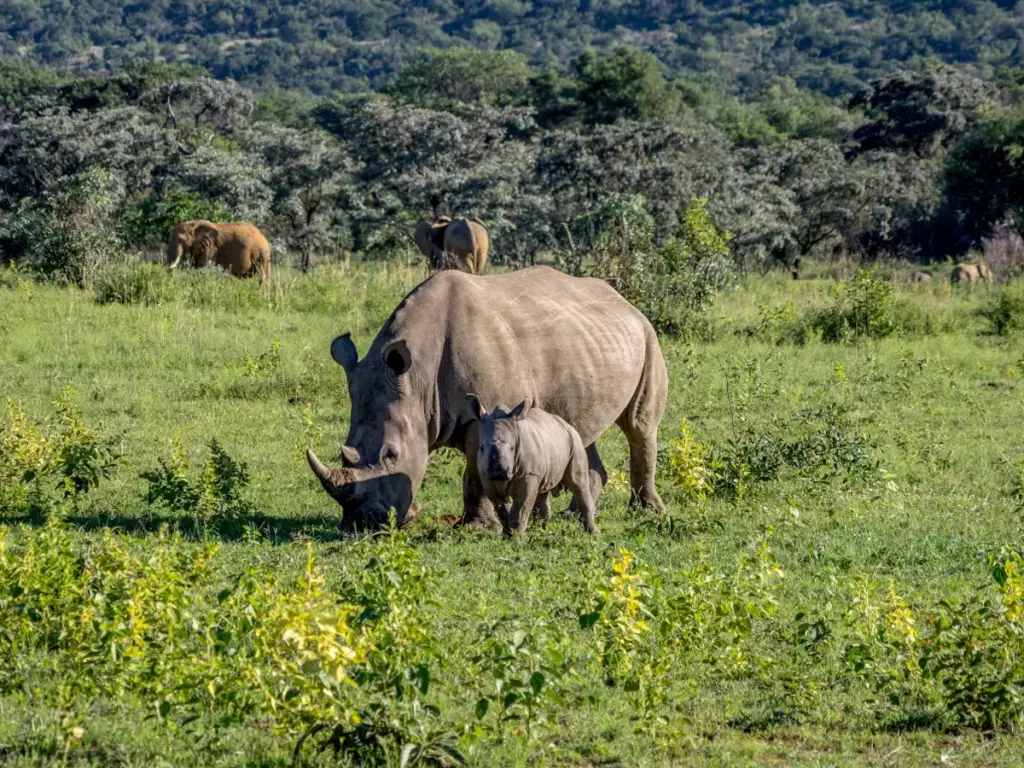
Welcome to the wild world of the Serengeti, where each corner holds a unique tale of nature’s wonders. Today, we are embarking on a journey into the world of rhinos, exploring the distinctions between the enigmatic Black Rhino and its counterpart, the White Rhino. Join us for a safari adventure as we uncover the differences between these magnificent creatures and reveal where you can spot them in the expansive plains of the Serengeti.
First off, let’s clear the air on their names – it’s not about color! The difference between Black Rhino and White Rhino actually has more to do with their mouths. The Black Rhino, also known as the hook-lipped rhino, has a pointed upper lip adapted for browsing leaves and twigs from trees and bushes. Meanwhile, the White Rhino, with its square-shaped mouth, is designed for grazing on grass.
But why the name “white” rhino if it’s not white? Well, the name is believed to be a mistranslation of the Afrikaans word “wyd,” meaning wide, referring to the broad, square-shaped mouth of the white rhino. Over time, “wyd” became “white” in English, leading to the misconception of its color.
Another notable difference lies in their size. While both are hefty beasts, the White Rhino takes the crown as the larger of the two, with a bulkier build compared to the more slender Black Rhino.
The majestic white rhino also has a large front horn that extends out in front of it, and its second horn, while shorter adds to its intimidating beauty. Now turn your attention to the black rhino. While shorter than its white counterpart, its front horn exudes dignity, and its second horn, which is a mirror image of its companion, is a marvel of symmetry.

White rhinos love to hang out in wide-open meadows or spacious areas, where they can indulge in their passion for grazing on grass. On the other hand, black rhinos prefer to strut their stuff in dense vegetation, which suits their browsing habits perfectly. You will often find them nibbling on leaves, shoots, and branches, showing off their fine dining skills amidst the lush greenery.
When it comes to speed, the black rhino takes the lead, sprinting at an impressive pace of 55 km/h (35 mph). Meanwhile, its counterpart, the white rhino, may not be as swift but still commands respect with a speed of 50 km/h (31 mph).

Now, let’s talk safari spots! The Serengeti, renowned for its breathtaking landscapes and diverse wildlife, serves as a prime habitat for both rhino species. Nevertheless, due to poaching and habitat loss, spotting these elusive creatures requires a keen eye and a touch of luck.
When it comes to Black Rhinos, your best bet is to explore areas with dense vegetation and rocky terrain. Look for them skulking in the shadows of acacia trees or hiding amidst shrub-filled thickets. The Seronera region, located in the heart of the Serengeti, is known to be a hotspot for Black Rhino sightings. Additionally, the Moru Kopjes, a series of granite outcrops, provide excellent hiding spots for these elusive creatures.
On the other hand, the White Rhino prefers open grasslands, making the expansive plains of the Serengeti their ideal stomping grounds. The Ngorongoro Crater, with its lush vegetation and diverse ecosystem, offers another opportunity to encounter these majestic creatures during your safari adventure. Keep your eyes peeled as you explore the rim and descend into the crater for a chance to witness rhinos in this unique and spectacular setting.

Now, let’s address the elephant in the room – or rather, the rhino! Both the Black Rhino and White Rhino face significant conservation challenges, with poaching posing a grave threat to their survival. The Black Rhino, in particular, has seen a drastic decline in numbers, with only a few thousand individuals remaining in the wild. Similarly, while the White Rhino boasts a larger population, it too faces ongoing threats.
But fear not, intrepid explorers! Conservation efforts are underway across Africa to protect these iconic species. In Africa, you can find both the Black Rhino and the White Rhino in various countries, including South Africa, Namibia, Zimbabwe, and Kenya.
So, whether you are on the lookout for the elusive Black Rhino or the majestic White Rhino, a safari adventure in the Serengeti promises an unforgettable experience. With its awe-inspiring landscapes and captivating wildlife, the Serengeti remains a beacon of hope for conservation efforts and a sanctuary for Africa’s most iconic species.